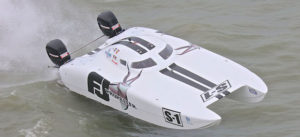
Pete Boden/Shoot 2 Thrill Pix
TNT is getting Gary Ballough’s new 32 foot Victory catamaran ready for the 2019 offshore racing season. In the article posted by Speedonthewater.com, Tomlinson goes into detail on how the rigging process will go and the time it will take to complete. Give us a call at 305-944-2118 with any questions regarding our rigging services. Read the article below for more information about the upcoming rigging for Ballough.
Sometime in the next month or so, TNT Custom Marine—the Miami based-business I own with Mike Thomas—will start setting up Gary Ballough’s new 32-foot Victory catamaran for the 2019 offshore racing season. Mike and his two-man crew will handle the job, which should take 150 to 200 hours. We’ve rigged a few boats for Gary before so we know what to expect, at least from him. I’ve known him for 30 years and at one point or another in the rigging process we usually have to throw him out of the shop once or twice with every job. He’s very intense and emotional, but we love him for it.
These days, we rig one or two new raceboats a year and four or five new pleasure boats a year. (Repowers and re-rigs, on the other hand, we do every week. They’re pretty much endless—I can’t even begin to count them.) How long a given raceboat rigging job takes depends entirely on how the boat shows up here—and we’re not sure what to expect from Gary’s new boat as it’s the first 32-foot Victory catamaran we will rig. Sometimes, we have to add all the hardware including fuel fill, latches, seat brackets and so on. Sometimes not. We really won’t know until the boat gets here, but I do know that Gary has already begun gathering the hardware we’ll need. That will help a lot.
In general, an outboard engine-powered raceboat takes about half as much time to rig as a stern-drive engine boat. Those jobs often involve us having to fabricate the engine rails, driveshaft covers, bilge pump brackets and other pieces of hardware we need to do the job. Sometimes we even have to install the windshield. As I said, it all depends what shape the boat arrives in—how raw it might be—and it’s rarely the same twice.
Original article posted by SpeedOnTheWater.com.






